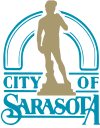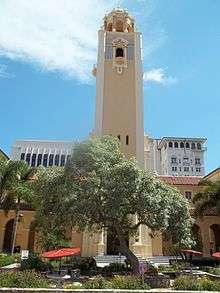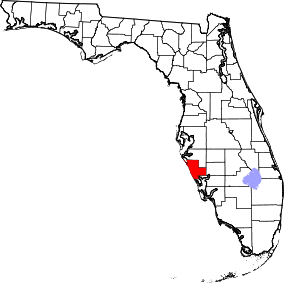Sarasota, Florida
| Sarasota, Florida | |||
|---|---|---|---|
| City | |||
.jpg) Sarasota Bay and waterfront | |||
| |||
| Nickname(s): SRQ,[1] Paradise,[2] Circus City | |||
| Motto(s): "Where Urban Amenities Meet Small-Town Living!"[3] | |||
|
Location in Sarasota County and the U.S. state of Florida | |||
 Sarasota, Florida Location in the United States | |||
| Coordinates: 27°20′14″N 82°32′7″W / 27.33722°N 82.53528°WCoordinates: 27°20′14″N 82°32′7″W / 27.33722°N 82.53528°W | |||
| Country | United States | ||
| State | Florida | ||
| County | Sarasota | ||
| Zarazote | 1763 | ||
| Fort Armistead | 1840 | ||
| Sara Sota | 1842 | ||
| Sarasota | 1902 | ||
| Government[4] | |||
| • Type | Commission–manager government | ||
| • City Mayor | Liz Alpert | ||
| • City Manager | Thomas Barwin | ||
| Area[5] | |||
| • City | 25.21 sq mi (65.31 km2) | ||
| • Land | 14.68 sq mi (38.02 km2) | ||
| • Water | 10.53 sq mi (27.28 km2) 42.58% | ||
| Elevation[6] | 16 ft (7 m) | ||
| Population (2010)[7] | |||
| • City | 51,917 | ||
| • Estimate (2016)[8] | 56,610 | ||
| • Density | 3,856.00/sq mi (1,488.77/km2) | ||
| • Metro | 720,042 | ||
| Time zone | UTC-5 (EST) | ||
| • Summer (DST) | UTC-4 (EDT) | ||
| ZIP code | 34230–34243 | ||
| Area code(s) | 941 | ||
| FIPS code | 12-64175[9] | ||
| GNIS feature ID | 0290675[10] | ||
| Website |
www | ||
Sarasota (/ˌsærəˈsoʊtə/) is a city in Sarasota County on the southwestern coast of the U.S. state of Florida. The area is renowned for its cultural and environmental amenities, beaches, resorts, and the Sarasota School of Architecture. The city is at the southern end of the Tampa Bay Area, north of Fort Myers and Punta Gorda. Its official limits include Sarasota Bay and several barrier islands between the bay and the Gulf of Mexico. According to the U.S. Census Bureau, in 2013 Sarasota had a population of 53,326. In 1986 it became designated as a certified local government. Sarasota is a principal city of the Sarasota metropolitan area, and is the seat of Sarasota County.
The islands separating Sarasota Bay from the gulf near the city, known as keys, include Lido Key and Siesta Key, which are famous worldwide for the quality of their sandy beaches. The keys that are included in the boundary of Sarasota are Lido Key, St. Armands Key, Otter Key, Coon Key, Bird Key, and portions of Siesta Key. Previously, Siesta Key was named Sarasota Key. At one time, it and all of Longboat Key were considered part of Sarasota and confusing contemporaneous references may be found discussing them.
Longboat Key is the largest key separating the bay from the gulf, but it is now evenly divided by the new county line of 1921. The portion of the key that parallels the Sarasota city boundary that extends to that new county line along the bay front of the mainland was removed from the city boundaries at the request of John Ringling in the mid-1920s, who sought to avoid city taxation of his planned developments at the southern tip of the key. Although they never were completed in the quickly faltering economy, those development concessions granted by the city never were reversed and the county has retained regulation of those lands.
The city limits had expanded significantly with the real estate rush of the early twentieth century, reaching almost 70 square miles (180 km2). The wild speculation boom began to crash in 1926 and following that, the city limits began to contract, shrinking to less than a quarter of that area.[11]
History
Geography and climate
According to the United States Census Bureau, the city has a total area of 25.9 square miles (67 km2), of which 14.9 sq mi (38.6 km2) is land and 11.0 sq mi (28 km2) is water.
Sarasota has a humid subtropical climate closely bordering a tropical savanna climate, with hot, humid summers, and warm, dry winters. There are distinct rainy and dry seasons, with the rainy season lasting from June to September, and the dry season from October to May. The most recent officially recorded freezes in Sarasota took place on January 4 and 5, 2012, when the temperature dropped to 32 degrees (zero degrees Celsius) at the Sarasota-Bradenton International Airport, however Sarasota averages less than one frost annually.[12]
| Climate data for Sarasota–Bradenton International Airport (1981–2010) | |||||||||||||
|---|---|---|---|---|---|---|---|---|---|---|---|---|---|
| Month | Jan | Feb | Mar | Apr | May | Jun | Jul | Aug | Sep | Oct | Nov | Dec | Year |
| Record high °F (°C) | 89 (32) |
90 (32) |
90 (32) |
94 (34) |
95 (35) |
100 (38) |
100 (38) |
99 (37) |
97 (36) |
95 (35) |
90 (32) |
89 (32) |
100 (38) |
| Average high °F (°C) | 70.9 (21.6) |
73.1 (22.8) |
76.2 (24.6) |
80.7 (27.1) |
85.6 (29.8) |
88.6 (31.4) |
89.8 (32.1) |
90.0 (32.2) |
88.8 (31.6) |
85.0 (29.4) |
78.8 (26) |
73.2 (22.9) |
81.7 (27.6) |
| Daily mean °F (°C) | 61.4 (16.3) |
63.4 (17.4) |
66.7 (19.3) |
71.1 (21.7) |
76.4 (24.7) |
80.8 (27.1) |
82.4 (28) |
82.3 (27.9) |
81.4 (27.4) |
76.4 (24.7) |
69.2 (20.7) |
63.5 (17.5) |
73.0 (22.8) |
| Average low °F (°C) | 51.8 (11) |
53.6 (12) |
57.1 (13.9) |
61.5 (16.4) |
67.2 (19.6) |
72.9 (22.7) |
75.0 (23.9) |
74.5 (23.6) |
74.0 (23.3) |
67.7 (19.8) |
59.6 (15.3) |
53.7 (12.1) |
64.1 (17.8) |
| Record low °F (°C) | 23 (−5) |
24 (−4) |
30 (−1) |
38 (3) |
46 (8) |
52 (11) |
62 (17) |
60 (16) |
59 (15) |
44 (7) |
29 (−2) |
20 (−7) |
20 (−7) |
| Average rainfall inches (mm) | 2.49 (63.2) |
2.70 (68.6) |
3.86 (98) |
2.44 (62) |
2.21 (56.1) |
7.51 (190.8) |
7.98 (202.7) |
9.14 (232.2) |
7.10 (180.3) |
3.12 (79.2) |
1.93 (49) |
2.53 (64.3) |
53.01 (1,346.4) |
| Source: NOAA[13] | |||||||||||||
Demographics
| Historical population | |||
|---|---|---|---|
| Census | Pop. | %± | |
| 1910 | 840 | — | |
| 1920 | 2,149 | 155.8% | |
| 1930 | 8,398 | 290.8% | |
| 1940 | 11,141 | 32.7% | |
| 1950 | 18,896 | 69.6% | |
| 1960 | 34,083 | 80.4% | |
| 1970 | 40,237 | 18.1% | |
| 1980 | 48,868 | 21.5% | |
| 1990 | 50,961 | 4.3% | |
| 2000 | 52,715 | 3.4% | |
| 2010 | 51,917 | −1.5% | |
| Est. 2016 | 56,610 | [8] | 9.0% |
| U.S. Decennial Census[14] | |||
As of the 2010 U.S. Census,[9] there were 51,917 people residing in the city. The population density was 3,541.4 inhabitants per square mile (1,367.3/km2). There were 29,151 housing units at an average density of 1,988.5 per square mile (767.8/km2). The racial makeup of the city was 75.41% White, 15.11% African American, 0.43% Native American, 1.33% Asian, 0.04% Pacific Islander, 5.22% from other races, and 2.34% from two or more races. Hispanic or Latino of any race were 16.63% of the population.
There were 23,427 households out of which 19.7% had children under the age of 18 living with them, 35.3% were married couples living together, 12.3% had a female head of household with no husband present, and 48.5% were non-families. 38.3% of all households were made up of individuals and 16.3% had someone living alone who was 65 years of age or older. The average household size was 2.12 and the average family size was 2.81.
In the city, 18.4% of the population was under the age of 18, 9.2% ranged from 18 to 24, 27.9% from 25 to 44, 22.5% from 45 to 64, and 22.0% were 65 years of age or older. The median age was 41 years. For every 100 females, there were 94.6 males. For every 100 females age 18 and over, there were 92.8 males.
The per capita income for residents of the city was $23,197. Females had a median income of $23,510 versus $26,604 for males. The median income for a household in the city was $34,077 and the median income for a family was $40,398. About 12.4% of families and 16.7% of the population were below the poverty line, including 28.5% of those under age 18 and 7.7% of those age 65 or over.
Economy
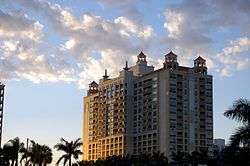
Tourism contributes significantly to the economy of Sarasota. Companies based in Sarasota include the Boar's Head Provision Company. Major employers include Sarasota Memorial Hospital, Doctors Hospital of Sarasota, APAC Customer Services, L-3 Aviation Recorders, The Zenith and Capgemini.[15]
Government
Sarasota municipal government was last incorporated in 1913, changing from a town type to adopting the city type of local government found in the United States and the title of its government changed to "City of Sarasota". Sarasota later was designated as the county seat when Sarasota County was carved out of Manatee County in 1921 during the creation of several new counties. In 1945 the commission-manager government form was adopted for the city and it is governed by a five-person commission elected by popular vote, two members of which serve in the ceremonial positions of "mayor" and "vice-mayor", as chosen by the commission every April. Two at-large commissioners are elected by all voters and the city is divided into three districts for which the residents of each elect one district representative to the five member commission.
Many aspects of the city are overseen by the county government ranging from the schools, the libraries, the bay, major waterways, county designated roads, the airport, fire departments, property and ad valorem taxes, voting, the health department, extension services, storm water control, mosquito control, the courts, and the jail. Therefore, the election of county commissioners is important to city voters.
In January 2006, the city of Sarasota made national news when the National Coalition for the Homeless and the National Law Center on Homelessness and Poverty ranked it number one on the groups' list of twenty "meanest cities" in America in their published report A Dream Denied: The Criminalization of Homelessness in U.S. Cities.[16] The city's adoption of its "no lodging out-of-doors" ordinance on August 15, 2005[17], Ordinance No. 05-4640, made it illegal to sleep outside on public property without permission, as was already the case with private property.
Sarasota is among the communities included in a two-county federally mandated Metropolitan Planning Organization that includes all of Sarasota and Manatee counties and the chairs of the three elements of that organization belong to the eight-county regional planning organization for western central Florida.[18]
Arts and culture
.jpg)
In 1925, A. B. Edwards built a theater that could be adapted for either vaudeville performances or movie screenings. It is at the intersection of Pineapple Avenue and Second Street, having been restored and used for operas. It is listed on the National Register of Historic Places.
Sarasota is the home of the Sarasota Orchestra, which was founded by Ruth Cotton Butler in 1949 and known for years as the Florida West Coast Symphony. It holds a three-week Sarasota Music Festival that is recognized internationally and boasts it attracts renowned teachers and the finest students of chamber music.
In the early 1950s, the John and Mable Ringling Museum of Art purchased a historic Italian theater, the "Asolo" (now called the Historic Asolo Theater). A. Everett "Chick" Austin, the museum's first director, arranged the purchase and reassembly of the theater for performances of plays and opera.
Later a local architect, Stuart Barger, designed and oversaw the construction of another Asolo Theater, housed in the Florida State University Center for the Performing Arts. It is a multi-theater complex, located farther east on the John and Mable Ringling Museum of Art property, being placed between Bay Shore Road and Tamiami Trail, and facing south toward Ringling Plaza. It was built around a rococo, historic Scottish theater, which had been shipped to Florida. The new complex also provides venues and facilities for students of Florida State University's MFA Acting program, the FSU/Asolo Conservatory for Actor Training. This was the administrative home of the Sarasota French Film Festival for several years.
In the 1960s the Van Wezels enabled the city to build a performing arts hall on the bay front. The auditorium, the Van Wezel Performing Arts Hall, was designed by Frank Lloyd Wright's successor firm, Taliesin Associated Architects team under the direction of William Wesley Peters. Wright's widow, Olgivanna Lloyd Wright, who participated in the project, selected its purple color.
Other Sarasota cultural attractions include the Sarasota Ballet, Sarasota Opera, Asolo Repertory Theatre, Florida Studio Theatre, the Sarasota Players, the Banyan Theater Company, and many other musical, dance, artistic, and theatrical venues. Florida Studio Theatre (FST) has been operating in downtown Sarasota since 1973. FST is a not-for-profit Theatre that produces contemporary plays, musicals, and musical revues. Currently, FST has four operational theatres; the Keating Mainstage, the Gompertz Mainstage, the Goldstein Cabaret, and the John C. Court Cabaret. Florida Studio Theatre also has three in-house restaurants, and is slated to open a new experimental space, The Bowne Lab, in early 2014. FST has the third highest subscription base of all TCG LORT Regional Theatres in the country.
Since 1998, the city has hosted the Sarasota Film Festival annually. The festival attracts independent films from around the world. It claims to be one of Florida's largest film festivals. In 2009 the annual Ringling International Arts Festival, held its premier and held its closing event in the historic Asolo theater, which had been moved and rebuilt again. The historic Venetian theater now is housed in the reception building for the museum where it is used for special events as well as performances, informative purposes, and another seasonal film series hosted by the museum.
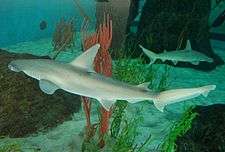
In 2010, the Sarasota Chalk Festival that is held yearly in the historic area of Burns Square became the first international street painting festival in the United States of America. Celebrating the sixteenth century performance art of Italian street painting, the festival hosted Maestro Madonnaro Edgar Mueller from Germany, who created the first street painting that changed images from day to night.[19][20][21][22] The festival has a different theme each year and has introduced new techniques in street art. Other applications of street art such as murals and "cellograff graffiti" have become companion events also produced by Avenida de Colores, Inc. The murals are part of the "Going Vertical" project and although it sometimes coincides with the chalk festival, it is distinct from it and often continues throughout the year. Except for a few commissioned on public property in the Palm Avenue Parking Garage, the murals are on private property and they are in many sections of Sarasota and in Manatee County as well. As of 2014 the Sarasota Chalk festival has relocated to Venice, FL, a small town just South of Sarasota. The name Sarasota Chalk Festival remains the same.
Sarasota is home to Mote Marine Laboratory, a marine rescue, research facility, and aquarium, the Marie Selby Botanical Gardens, and the Sarasota Jungle Gardens. It also has many historic sites and neighborhoods.
Architecture
Italian architecture and culture are quite strong in the area because of the Ringling Museum. An unusually large number of homes and buildings are designed in the Italian style, especially Venetian as influenced by Ringling's Cà d'Zan. Italian inspired statues are also common and Michelangelo's David is used as the symbol of Sarasota.
Sarasota School of Architecture
The Sarasota School of Architecture developed as a variant of mid-century modernist architecture. It incorporates elements of both the Bauhaus and Frank Lloyd Wright's "organic" architecture. The style developed as an adaptation to the area's sub-tropical climate and used newly emerging materials manufactured or implemented following World War II. Philip Hiss was the driving force of this movement.
Fellow architects creating new adaptive designs were Paul Rudolph and Ralph Twitchell. The second generation of the school includes Gene Leedy, Jack West, Victor Lundy, Mark Hampton, William Rupp, James Holiday, Ralph Zimmerman, as well as several who still practice in the community: William Zimmerman; Carl Abbott, Edward J. "Tim" Seibert, and Frank Folsom Smith.
Rudolph's Florida houses attracted attention in the architectural community around the world. He started receiving commissions for larger works, such as the Jewett Art Center at Wellesley College. In 1958 Rudolph was selected as director of the School of Architecture at Yale, shortly after designing the school's building. He led the school for six years before returning to private practice.
Recently a bank building designed and built by Jack West was renovated and reopened as the headquarters of Gateway Bank on Tamiami Trail at the intersection with Bahia Vista. This followed a preliminary proposal to demolish the building that met with a rapid objection from a leader of historic preservation in the community, Kafi Benz, before the new project could gain approval within the city planning department. The building is graced by a sculpture by Jack Cartlidge that was installed when the building was built.
Historic buildings and sites
By the end of the twentieth century, many of Sarasota's more modest historical structures were demolished. Recently, two historic buildings, the Crocker Church and the Bidwell-Wood House (the oldest remaining structure in the city),[23] first restored by Veronica Morgan and members of the Sarasota Alliance for Historic Preservation that she founded, became city property. These structures were relocated to this park, despite protests from residents who objected to the loss of park area.
In the late 1970s, Sarasota County purchased the Terrace Hotel that was built by Charles Ringling and renovated it for use as a county government office building.[24] The adjacent courthouse that he donated to the new county in 1921 has been listed on the National Register of Historic Places. The courthouse complex was designed by Dwight James Baum.
In the next decade the landmark hotel built by Owen Burns, the El Vernona, which had been turned into apartments became endangered. By then it was called the John Ringling Towers and was purchased by a phosphate miner, Gardinier, who wanted to turn it into his corporate headquarters. All of the tenants were turned out and plans were made for the restoration of the building. The city commissioners supported the plan initially, but lobbying to undermine the project began and one of the commissioners changed her vote. The project was denied at the final hearing. The enraged miner abandoned the city and subsequent owners, seeking to demolish it, made garish changes to the building to make it unappealing before finally leaving it open for vagrants to invade and pilfer.
Remarkable preservation success occurred during the 1990s when the community exhibition hall, the Municipal Auditorium, designed by Thomas Reed Martin and Clarence A. Martin, was listed on the National Register of Historic Paces and meticulously restored to its depression recovery era, 1937 WPA community project, completion status and its architectural glory—both inside and out. The city boasts that 100,000 people use it every year and it is a boon to the community for recreation, lawn sports, as well as being heavily attended for auctions, concerts, conventions, flea markets, galas, graduations, lectures, orchid and flower shows, and a full range of trade shows of interest to the community. Later the Federal Building, designed by George Albee Freeman (the designer of Seagate for the Crosleys) and Louis A. Simon, which initially had served as the post office was restored as well.
Most of the luxurious historic residences from the 1920s boom period along the northern shore of Sarasota Bay also have survived. This string of homes, built on large parcels of elevated land along the widest point of the bay, is anchored by the John and Mable Ringling Museum of Art at its center. Among them is Cà d'Zan, the home of Mable and John Ringling, which was restored recently.
Many significant structures from the comparatively recent "Sarasota School of Architecture" period of the mid-twentieth century, however, have not survived. Since they do not qualify under the age criteria set for historic preservation nominations their historical aspect often escapes public recognition. Others frequently are threatened by demolition plans for new development without consideration of their cultural and historical importance to the community instead of motivating the implementation of plans to retain the buildings and integrate them into new plans.
In 2006, the Sarasota County School Board slated one of Paul Rudolph's largest Sarasota projects, Riverview High School, for demolition. The board arrived at the decision despite protests by many members of the community, including architects, historic preservationists, and urban planners. Others supported the demolition as they believed the structure is no longer functional. The issue was divisive. The World Monuments Fund included the school on its 2008 Watch List of 100 Most Endangered Sites in the category Main Street Modern.
Following a March 2007 charrette led by the National Trust for Historic Preservation, a proposal was advanced to renovate and preserve Rudolph's buildings. The school board decided to allow a year to consider implementation of the innovative plan proposed to preserve the buildings, that would include building a parking garage with playing fields above it rather than demolishing the structures. In early June 2008, the school board voted in a 3-2 decision to allow the demolition; School board members Shirley Brown, Caroline Zucker and Frank Kovatch voted against preserving the historic high school.[25] This decision was that school would be demolished and that a parking lot would replace it. One year later, in June 2009, Riverview High School was demolished.[26]
Other notable cultural features
Several movies have been shot using Sarasota locations. One focusing on the Going Vertical program of street art that is held by the Sarasota Chalk Festival premiered internationally when muralist MTO released his documentary film,[27] FL: unpremeditated movie, about some of his work in Sarasota.[28][29][30][31] It is only one of many international films produced about the festival and its artists.
Breaking Amish: Brave New World is a television series set in Sarasota in the neighborhood of Pinecraft. It is a spin-off of Breaking Amish.
The show Cougar Town on TBS takes place in Sarasota, but is filmed in California.
The Westcoast Black Theatre Troupe of Florida (WBTT) was founded in December 1999, by local actor, singer, director, and playwright Nate Jacobs. It is the only professional black theater company on Florida's west coast and one of two in the state. Through the years WBTT has produced many productions locally, throughout Florida, nationally, and as far away as Switzerland and Germany.
Education
Public education
Public education is provided and managed by the Sarasota County Public Schools school district.
Elementary schools in Sarasota include the following:
- Alta Vista Elementary
- Ashton Elementary
- Bay Haven School of Basics Plus
- Brentwood Elementary
- Emma E. Booker Elementary
- Fruitville Elementary
- Gocio Elementary
- Gulf Gate Elementary
- Lakeview Elementary
- Laurel Nokomis School
- Phillippi Shores Elementary
- Southside Elementary
- Tatum Ridge Elementary
- Tuttle Elementary
- Wilkinson Elementary
Middle schools include Booker Middle, Brookside Middle, Laurel Nokomis, McIntosh Middle, and Sarasota Middle.
High schools include Booker High, Riverview High, Sarasota High, Suncoast Polytechnical High School, Sarasota Military Academy, and Oak Park School.
Sarasota was also home to the Flint School, a type of boating school.
Higher education
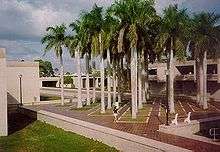
Sarasota is home to the New College of Florida, a public liberal arts college.
Additional colleges in Sarasota include Keiser University of Sarasota (a private, not for profit university); FSU/Asolo Conservatory for Actor Training (Florida State University's MFA Acting Conservatory in conjunction with the Asolo Repertory Theatre); Ringling College of Art and Design, a school of visual arts and design; and satellite campuses of Eckerd College, based in St. Petersburg, Florida; and Florida State University College of Medicine, based in Tallahassee, Florida. Other colleges in the city include East West College of Natural Medicine, an accredited college of acupuncture and Chinese medicine.
Nearby educational institutions with regional draw include State College of Florida, Manatee-Sarasota, and a commuter branch of the University of South Florida, with the main campus located in Tampa.
Media
Television
Sarasota is part of the Nielsen-designated Tampa-Saint Petersburg-Sarasota television market.[32] The local television stations are ABC-affiliate WWSB and the SNN: Suncoast News Network, a continuous local cable news operation run by Comcast, Frontier FiOS and the Sarasota Herald-Tribune. WWSB is the only network station with studios in Sarasota. Other network and public television programming serving the community is offered by Fort Myers and Tampa television stations. Comcast provides cable television service. DirecTV and Dish Network direct broadcast satellite television including Tampa Bay Area local and national channels to Sarasota residents.
Radio
Arbitron has identified the Sarasota-Bradenton radio market as the seventy-third largest market in the country,[33] and the sixth largest in the state of Florida. There are eight radio stations in the city: WSMR (89.1FM, classical music), WSLR-LP (96.5FM, variety-talk and community issues), WKZM (104.3FM, religious; repeating WKES Lakeland), WSRZ (107.9FM, oldies), WLSS (930AM, talk), WSRQ (1220AM, 98.9FM, 106.9FM, talk), WTMY (1280AM, talk), WTZB (105.9FM, rock music; commonly known as The Buzz) and WSDV (1450AM, adult standards). WHPT (102.5 FM, Hot Talk) and WRUB (106.5FM, Spanish) are licensed to Sarasota and have broadcasting facilities in the Sarasota / Bradenton area, but have studios in the Tampa Bay area and are focused on that region.
The community also is served by most radio stations from the Tampa Bay radio market, as well as some stations from the nearby Fort Myers radio market.
Newspaper
The Sarasota Herald-Tribune is the daily newspaper published in the city. SRQ Daily is published electronically on a daily basis and the Sarasota Observer has changed from a weekly to a daily. A weekly newspaper includes the electronic This Week In Sarasota, TWIS. From neighboring Manatee County, the Bradenton Herald also is distributed daily in the area and The Bradenton Times is an electronic weekly newspaper that covers Sarasota topics as well. Founded in 1957, Scene Magazine is the longest running community lifestyle magazine.[34]
Sports and recreation
Sports
Stadiums
In 1937 the Municipal Auditorium-Recreation Club was built with funds provided by the Works Progress Administration, the municipal government, and local residents and business owners. It became a center for sports, entertainment, and recreation. The sports activities have ranged from badminton, basketball, boating, lawn bowling, and shuffleboard, to tennis. The auditorium hosts clubs for cards, dancing, games, gardening, and numerous hobbies as well as having become the community meeting place for commercial and educational shows and the venue for local schools and charities to hold events and dances. Tourists are attracted to exhibitions provided by local businesses as well as vendors from national circuits. This building was listed in the National Register of Historic Places because of its architecture and for providing the enormous range of community activities that are scheduled at it every week.
Sarasota also is home to Ed Smith Stadium, where the Baltimore Orioles currently have spring training. The Orioles also have minor league facilities at Twin Lakes Park. Both facilities will undergo major upgrades after spring training in 2010. The agreement with the Orioles also places a Cal Ripken Youth Baseball Academy in Sarasota.[35] Previously, Ed Smith Stadium was the spring training home of the Cincinnati Reds and the minor league Sarasota Reds.
Golf
The warm climate helped the Sarasota area become a popular golf destination. John Hamilton Gillespie was an early pioneer of the game in Sarasota. The Sara Bay course in the Whitfield area was designed by golf architect Donald Ross. Bobby Jones was associated with the community course in Sarasota. Many courses dot the area, including the one originally laid out for the hotel John Ringling planned on the southern tip of Longboat Key.
Fishing
Sport fishing attracted enthusiasts to Sarasota and the area because of the amazing bounty of the bay. Tarpon was the biggest draw, but gigantic gar as well as many other species abounded to attract people such as Owen Burns and Powel Crosley. The first settled permanently and became one of the most important developers of Sarasota and the second, who more typically, built a winter retreat here and participated in the sport via the clubs, organizations, and tournaments focused on fishing.
Marathon
The Sarasota Marathon started in 2005. In 2010, declining sponsorship and marathon registration led organizers to change the event to a half marathon. The race begins and ends near the John and Mable Ringling Museum.[36]
Swimming
.jpg)
Sarasota is home to two swim teams. The most well-known, the Sarasota Sharks, have been around for many years and have won numerous national championships. The newer team, the Sarasota Tsunami, was founded by the former Sharks head coach. The teams maintain a rivalry.[37]
Sailing
The Sarasota Sailing Squadron is a highly active facility that has hosted many nationally renowned regattas for both dinghies and larger vessels.[38]
Football
In 2013, Sarasota became the home of the Sarasota Thunder, which was to play in the Ultimate Indoor Football League, but the team folded.[39]
2014 Pentathlon World Cup Final
In 2014, Sarasota hosted the modern pentathlon World Cup Final.[40]
2017 World Rowing Championships
Benderson Park in Sarasota was the venue for the World Rowing Championships in 2017, held on September 23 – October 1, 2017.[41]
Other Recreational Activities
Sarasota is home of the Whiskey Obsession Festival, the largest whiskey festival in Florida. Established in 2013, the festival features several hundred whiskies from around the world. Dozens of professional brand ambassadors and distillers participate in the festival by participating in a panel discussion, leading classes and tastings.[42]
Transportation
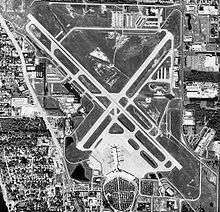
Airports
The major airport in the area is Sarasota-Bradenton International Airport which is shared by Sarasota and Manatee counties.[43] It has since being opened in 1941 the areas major airport. Before this, Lowe's Field functioned as the main airport for the Sarasota Area from 1929–1941.[44][45] Five airlines offer service out of the airport to locations primarily in the United States and Canada. The airport serves more than 1,300,000 passengers per year. The airport holds full port of entry status providing U.S. Customs inspections for international travelers.[43] St. Petersburg-Clearwater International Airport and Tampa International Airport are located about an hour north from Sarasota, and Southwest Florida International Airport in Ft. Myers an hour and 45 min south of Sarasota. All 3 offer a wider range of national and international flights.
Public Transit
Sarasota County Area Transit has a bus service called SCAT which offers service throughout the county and also offers limited connections with Manatee County Area Transit. Sarasota County has joined the Tampa Bay Area Regional Transportation Authority to plan and build future transportation infrastructure including light rail, commuter rail and longer range bus service.
Rail
A key issue is providing Sarasota with access to the Florida High Speed Rail. The Seaboard Coast Line ran intercity train service to the city until 1971.[46] There is no Amtrak train which stops in Sarasota, but Amtrak provides through-bus service at Sarasota Station, in front of the downtown Hollywood 20 Cinema Complex, to the nearest Amtrak terminal in Tampa. A freight-only rail line operated by Seminole Gulf Railway does serve industries in Sarasota.
Water
As a city located on the Gulf of Mexico, water transportation is a key consideration. The Intracoastal Waterway is a 3,000-mile (4,800 km) waterway providing water access to and from the Atlantic coast for tugs, barges and leisure boats. Port Manatee and the Port of Tampa both provide nearby deep water ports.[43] Port Manatee provides cargo service primarily while the Port of Tampa is more diverse. Port Manatee formerly even had a cruise line, Regal Cruise Line that operated out of in from 1993–2003 until it was seized by U.S Marshals on April 18, 2003 for not being maintained.[47][48] The waterway enters Sarasota Bay which provides access to downtown Sarasota at the city pier.
Road
Because of its location on the Gulf of Mexico and its proximity to several other large metropolitan areas, road transportation is critical to the Sarasota area. The major roads in the area include:





Roundabouts
Following the introduction of the work of Michael Wallwork to the city by a member of the Sarasota-Bradenton Metropolitan Planning Organization's citizen's advisory committee, Sarasota has adopted the use of modern roundabouts for intersections in several locations in the city. The municipal government intends to construct a series of modern roundabouts along Tamiami Trail that will become a national example of the success of the innovation. After building one at the intersection of Main Street, Pineapple Avenue, and Central Avenue, a series has been constructed nearby along Charles Ringling Boulevard at the entrance to the historic Burns Square area.
Notable people
- Ian Desmond, professional baseball player for the Colorado Rockies
- Brian Johnson, musician
- Mirjana Lučić-Baroni, professional tennis player
- Jes Macallan, actress
- Randy Savage, professional wrestler
- Sam Shields, professional National Football League player
- Nik Wallenda, tightrope walker
- Stephen King, author
- Jerry Springer, television personality
Twin towns – sister cities
The city commission has chosen to designate the following cities as sister cities, which are cooperative agreements between communities in geographically and politically distinct areas with the stated contemporary objective of promoting cultural and commercial ties. A twinning tradition began with an agreement between two towns, the German city of Paderborn and the French city of Le Mans in 836. The modern adaptation in the United States began in 1931.








See also
References
- ↑ [SRQ Magazine http://www.srqmagazine.com/]
- ↑ LaHurd, Jeff, Come on Down! : Pitching Paradise During the Roaring 20s, Sarasota Alliance for Historic Preservation, 1995 ISBN 978-1-888438-00-0 ISBN 1888438002
- ↑ "The City of Sarasota Florida Website". The City of Sarasota Florida Website. Retrieved September 21, 2012.
- ↑ "City Commission". City of Sarasota. Retrieved May 12, 2018.
- ↑ "2016 U.S. Gazetteer Files". United States Census Bureau. Retrieved July 7, 2017.
- ↑ "Sarasota, United States Page". Falling Rain Genomics. Retrieved July 24, 2007.
- ↑ "Annual Estimates of the population for the Incorporated Places of Florida" (XLS). U.S. Census Bureau. Retrieved June 25, 2014.
- 1 2 "Population and Housing Unit Estimates". Retrieved June 9, 2017.
- 1 2 "American FactFinder". United States Census Bureau. Retrieved January 31, 2008.
- ↑ "US Board on Geographic Names". United States Geological Survey. October 25, 2007. Retrieved January 31, 2008.
- ↑ Cummings, Ian, Razing near for city icon, Sarasota Herald-Tribune, page BNV1, June 15, 2014
- ↑ Cole, Brian (February 1, 2012). "Tampa Bay Area National Weather Service Climate Page". Tampa Bay Area National Weather Service. National Weather Service. Retrieved October 15, 2015.
- ↑ "NOWData – NOAA Online Weather Data". NOAA. 2016. Retrieved May 14, 2016.
- ↑ "Census of Population and Housing". Census.gov. Retrieved June 4, 2015.
- ↑ "EDC". suncoastbizresource.com. September 15, 2013. Archived from the original on September 15, 2013.
- ↑ "Narratives of the Meanest Cities – National Coalition for the Homeless". Retrieved April 2, 2010.
- ↑ "Public Hearing Re: Proposed Ordinance No. 14-5093". City of Sarasota. April 11, 2014. p. 3. Retrieved September 11, 2018.
- ↑ "Welcome to the Chairs Coordinating Committee Website". Charis Coordinating Committee. Retrieved August 30, 2010.
- ↑ Walter, Nick (October 27, 2010). "Ground-breaking Street Painting". Pelican Press. JCPGroup. p. Features. Archived from the original on June 14, 2011.
- ↑ Toner, Moira (November 3, 2010). "Students chalk up accomplishments". Pelican Press. JCPGroup. p. Local News.
- ↑ Weingarten, Abby (October 28, 2010). "Street art goes global this year". Sarasota Herald Tribune. The New York Times Company. p. E6.
- ↑ Ball, David (October 23, 2010). "Artists to make the pavement come alive in Sarasota". Sarasota Herald Tribune. The New York Times Company. p. BN1. Retrieved December 7, 2010.
- ↑ Jennings, David, A Tale of Two Commissions, Sarasota Alliance for Historic Preservation, Inc. Newsletter, February 2005, volume twenty, number two, Box 1754, Sarasota, Florida 34230 – with illustrations of Crocker Church and Bidwell-Wood House by Kafi Benz
- ↑ LaHurd, Jeff, Sarasota, A History, The History Press, Charleston, South Carolina, IBSSN 1-59629-119-2
- ↑ http://www.sarasota.k12.fl.us/Agenda2/June%2017,%202008%20Board%20Meeting%20on%20Tuesday,%20June%2017,%202008/91C1D8DA-C2A9-4C96-B192-147632B7E9B4Minutes.htm
- ↑ Joyce Owens (July 11, 2009). "Rudolph's Riverview High School Demolished". originally published on News-press.com. Do.co.mo.mo-us.org. Retrieved August 27, 2010.
- ↑ MTO, FL: unpremeditated movie, 2013, Berlin, Germany
- ↑ Rojo, Jamie and Harrington, Steven, "Unpremeditated" Movie from Street Artist MTO is a Knock Out, Huffington Post, March 20, 2013
- ↑ Freundeskreis Street-Art Berlin MTO Dokumentation: FL: unpremeditated movie
- ↑ Dokumentaalika & Stencibility | Genialistide Klubi. Genklubi.ee (March 16, 2013). Retrieved on July 17, 2013.
- ↑ Smith, Jessi, Get a ringside seat: MTO is not pulling any punches in his latest mural, This Week in Sarasota, December 20, 2012
- ↑ "Top 50 TV markets ranked by households". Northwestern University Media Management Center. Archived from the original on August 7, 2007. Retrieved September 3, 2007.
- ↑ "Arbitron Radio Market Rankings: Spring 2007". Arbitron. Retrieved September 3, 2007.
- ↑ "About Us". Sarasota Scene Magazine.
- ↑ "Topic Galleries -- baltimoresun.com". baltimoresun.com. July 21, 2012. Archived from the original on July 21, 2012.
- ↑ "2008 Sarasota Marathon". 2008 Sarasota Marathon. Retrieved January 8, 2009.
- ↑ "Sarasota Sharks :". www.teamunify.com. Retrieved August 25, 2018.
- ↑ 2006 Opti Nationals. Sarasotasailingsquadron.com (July 30, 2006). Retrieved on July 17, 2013.
- ↑ "FOOTBALL: Sarasota Thunder coming in 2013 – HT Preps". HT Preps. August 12, 2012. Retrieved August 25, 2018.
- ↑ "Sarasota-Bradenton to host the Olympic sport of Modern Pentathlon". Visit Sarasota Florida Beaches and Beyond | Official Travel Guide. December 3, 2013. Retrieved August 25, 2018.
- ↑ "Council approves Benderson Park for 2017 World Rowing Championships". MySuncoast. August 5, 2013. Retrieved August 6, 2013.
- ↑ "Whiskey Obsession Festival". www.whiskeyobsessionfestival.com. Retrieved August 25, 2018.
- 1 2 3 "By Air, Sea and Road". Manatee Chamber of Commerce. Retrieved September 10, 2010.
- ↑ "Municipal Airport/Lowe Field | Sarasota History Alive!". www.sarasotahistoryalive.com. Retrieved 2018-08-08.
- ↑ "Abandoned & Little-Known Airfields: Florida, Southern Tampa area". www.airfields-freeman.com. Retrieved 2018-07-23.
- ↑ Sarasota History Alive, "Atlantic Coast Line Railroad Depot." http://www.sarasotahistoryalive.com/history/markers/atlantic-coast-line-railroad-depot/
- ↑ "Cruise Line & Ship Profiles". www.cruiseserver.net. CRUISEPAGE.COM. Retrieved 2018-09-22.
- ↑ Jones Sr., James A. (2018). "Port Manatee has been without cruise service for 15 years. He's trying to bring it back". Bradenton Herald. Retrieved 2018-09-22.
- ↑ "Hamilton, Province of Ontario, Canada: 1990". Sarasota Sister Cities Association. Archived from the original on February 8, 2007. Retrieved September 3, 2007.
- ↑ "Perpignan, Languedoc-Roussillion, France: 1994". Sarasota Sister Cities Association. Archived from the original on March 29, 2012. Retrieved September 3, 2007.
- ↑ "Tel Mond, Israel:1994". Sarasota Sister Cities Association. Archived from the original on April 3, 2012. Retrieved September 3, 2007.
- ↑ "Vladimir, Russia:1994". Sarasota Sister Cities Association. Archived from the original on January 1, 2013. Retrieved September 3, 2007.
- ↑ "Town Twinning". www.fifedirect.org.uk. Retrieved January 15, 2018.
- ↑ "Treviso, Italy: 2007". Sarasota Sister Cities Association. Archived from the original on January 1, 2013. Retrieved September 3, 2007.
- ↑ "Siming District, Xiamen, Fujian Province, China:Candidate City". Sarasota Sister Cities Association. Archived from the original on March 29, 2012. Retrieved September 3, 2007.
External links
| Wikimedia Commons has media related to Sarasota, Florida. |

- Official website

